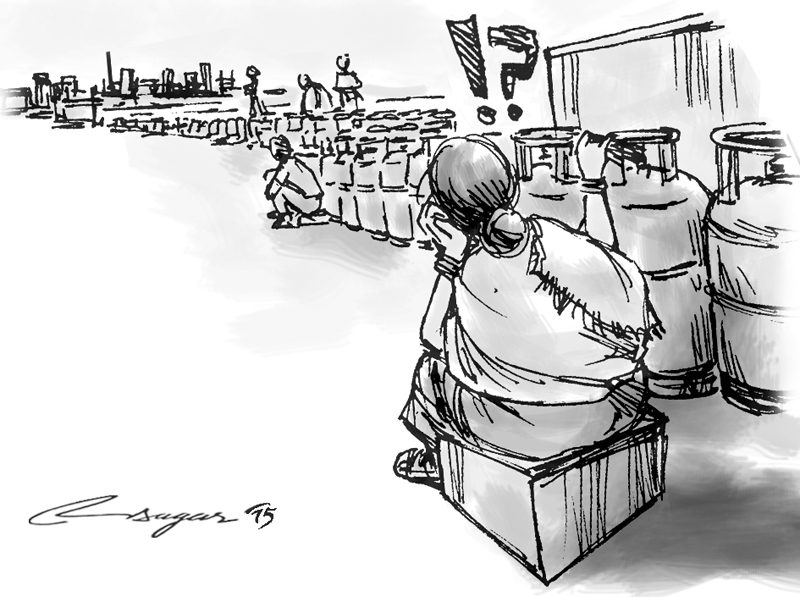Nepal’s humanitarian response: Best amongst worst options
An acceptable option would be a UN humanitarian operation in the most affected districts for the time being, which could be a shield for Nepal’s sovereignty and independence from outside infringement
Nepal is faced with a dilemma -- whether to please its next door neighbor or respond to the humanitarian crises befallen to its millions of people. The challenges that Nepal faces today are daunting because of the devastating April and May earthquakes and border obstructions by agitating Madhesh-centric groups followed by the ‘de-facto economic blockade’ against the country.
The latest crisis began when Nepal’s elected Constituent Assembly promulgated on 20th September the long-awaited constitution that caused disturbances in the southern plains of Terai-Madhesh among groups with close ethnic ties to India that feel under-represented.
Neither Nepal nor India, till today, have officially notified about the ‘hidden reasons’ of the imposition of ‘economic blockade’, unlike in the case of 1989 Indian embargo of Nepal that finally ended with a change of regime in Nepal. Also, there is no indication yet from both governments about their efforts to bring normalcy in trade and transit. Shockingly, over 50 days of diplomatic standoff passed without signs of reconciliation. Instead, the economy of Nepal has been pushed to the brink with a loss crossing over NRs 700 billion now.
The on-going blockade since 21st September has led to intense humanitarian sufferings. But the most troubling part of this ruination is shortages of fuel which have severely hampered humanitarian assistance to earthquake-affected areas according to United Nations Organizations for Humanitarian Assistance (UN OCHA) whereas more than 80,000 families or 400000 persons are in desperate need of shelter and food before snows. The time to resolve the existing predicament is running out fast. The humanitarian community sees this as one of the worst moments they ever had to confront.
The current scenario demands immediate actions to resolve the current national crises. The worst case scenario would be a triangular standoff between Nepal and the Madheshi groups and India. The fourth better but unlikely scenario would be that Nepal prevails in the current confrontation and Nepal maintains relations with India on status-quo-ante. The third better scenario would be to reach an agreement with India at G-to-G level and put pressure upon Madhesi groups to accept the agreement they reached, and open up all border points with China. The second best scenario for the immediate solution of the current crises would to seek UN humanitarian intervention. The best option would be to reach a mutual agreement with agitating Madhesi forces and to meet their demands through consistent dialogue and constitution amendment.
It is also notable that the UN Inter-Agency Standing Committee’s Emergency Response Preparedness approach has been also rolled out in Nepal and it remains a priority country for emergency response preparedness. According to UN yardstick, Nepal is the fifth country in the world today with incidence of severe humanitarian crisis after Iraq, Central African Republic, South Sudan and Syria. The only difference in Nepal’s case is that UN has declared the highest-level humanitarian emergency ‘Level 3’ in these four countries.
According to UN terminology Nepal’s present case is of Complex Emergency category. UN General Assembly Resolution Number 46/182 of 19th December 1991 has to be invoked to declare ‘Level 3 Emergency’ in the respective member state which indicates to the international community that help is desperately and urgently needed. Level 3 declaration means that the situation requires a significant response from the humanitarian system, rather than an indication of the severity of the crisis.
Most importantly and unassumingly at United Nations Human Rights Council’s deliberations in Geneva, Deputy Prime Minister and Minister for Foreign Affairs Kamal Thapa on the 6th of November gave a very powerful message to the international community, ‘that the country is plunging into a humanitarian crisis.’ On 8th November United Nations Children Fund warned that Nepal’s children are facing a new humanitarian crisis, severely impacting their health and compounding their misery.
On 10th November came the statement of International Red Crescent Movement and Nepal Red Cross indicating that their humanitarian activities such as blood supply and ambulance service have been impacted by shortages of fuel and the Terai-Madhesh security situation. Additionally, on 11th November, UN Secretary General Ban Ki-moon reiterated Nepal’s right of free transit as a landlocked nation as well as for humanitarian reasons, called all sides to lift the obstructions that have been impeding planned deliveries to earthquake-affected villages in Nepal. Nepal’s geo-political setting doesn’t permit bilateral involvement of neighbors in humanitarian missions. If the best option is not attainable at this juncture to forge a mutual agreement with agitating Madhesi forces and to meet their demands through consistent dialogues and constitution amendment; the only acceptable option would be a UN humanitarian operation in the most affected districts for the time being, which could be a shield for Nepal’s sovereignty and independence from outside infringement.
Acharya is member of the high-level committee formed to draft the Common Policies and Programs of the present coalition government






